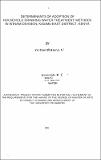| dc.description.abstract | This research project report is about the study of determinants of adoption of household drinking water treatment methods in Winam Division, Kisumu East District, Kenya. In many parts of the developing world, drinking water is collected from unsafe surface sources outside the home and is then held in household storage vessels. Drinking water may be contaminated at the source or during storage. Strategies to reduce waterborne disease transmission must safeguard against both events. Access to safe drinking water is essential to health, a basic human right and a component of effective policy for health protection. In Kenya, diarrhoeal diseases are among the top ten (10) causes of morbidity and mortality. Diarrhoea is ranked number three (3) in most rural public health facilities. According to the Ministry of Health (MOH) National Health Sector Strategic Plan (2005 - 2010), treating water at the household level has been shown to be one of the most effective and cost-effective means of preventing waterborne disease in development and emergency settings. Promoting household water treatment and safe storage (HWTS) helps vulnerable populations to take charge of their own water security by providing them with the knowledge and tools to treat their own drinking water. The purpose of the study was to investigate determinants of adoption of household drinking water treatment methods in Winam division, Kisumu East district, Kenya. The objectives of the study were to: - Investigate the extent to which household socio-economic status determines adoption of household drinking water treatment methods in Winam Division, Kisumu East District; Examine how knowledge on household drinking water treatment methods determines adoption of household drinking water treatment methods in Winam Division, Kisumu East District; Determine the extent to which accessibility to household drinking water treatment methods determines adoption of household drinking water treatment methods in Winam Division, Kisumu East District; and Assess how source of household drinking water determines adoption of household drinking water treatment methods in Winam Division, Kisumu East District. The study employed a descriptive survey study design, using both quantitative and qualitative techniques of data collection; the quantitative technique answered occurrence, while the qualitative technique sought to answer the ''why?'' aspect of the study. The quantitative technique involved the use of questionnaires while the qualitative technique involved the use of key informant interviews (KIIs). The study used a sample size of 384 households. The researcher employed multi stage random sampling to arrive at the sample size. Quantitative data was analyzed using descriptive statistics, including frequency tables and cross tabulations. Statistical Package for Social Scientists (SPSS) software version 17.0 was used to aid the analysis of the quantitative data. Qualitative data was grouped into respective themes and described in verbatim to enhance deeper understanding of the description of the quantitative data, guided by the study objectives and questions. From the discussions on the findings, the study concluded that household socio-economic status, knowledge on household drinking water treatment methods, accessibility to household drinking water treatment methods and household drinking water source determined adoption of household drinking water treatment methods. The study report recommends that health promoters should design messages focusing on risks of not treating drinking water and the benefits of treating drinking water. Public health workers should also train community health workers on effective delivery of messages on household drinking water treatment methods and design a sustainable public campaign strategy to ensure sustained adoption of household drinking water treatment methods. Suggestions for further studies are: (1) Sustainability of adoption of water treatment methods and (2) Health seeking behaviour for drinking water treatment. | en_US |

